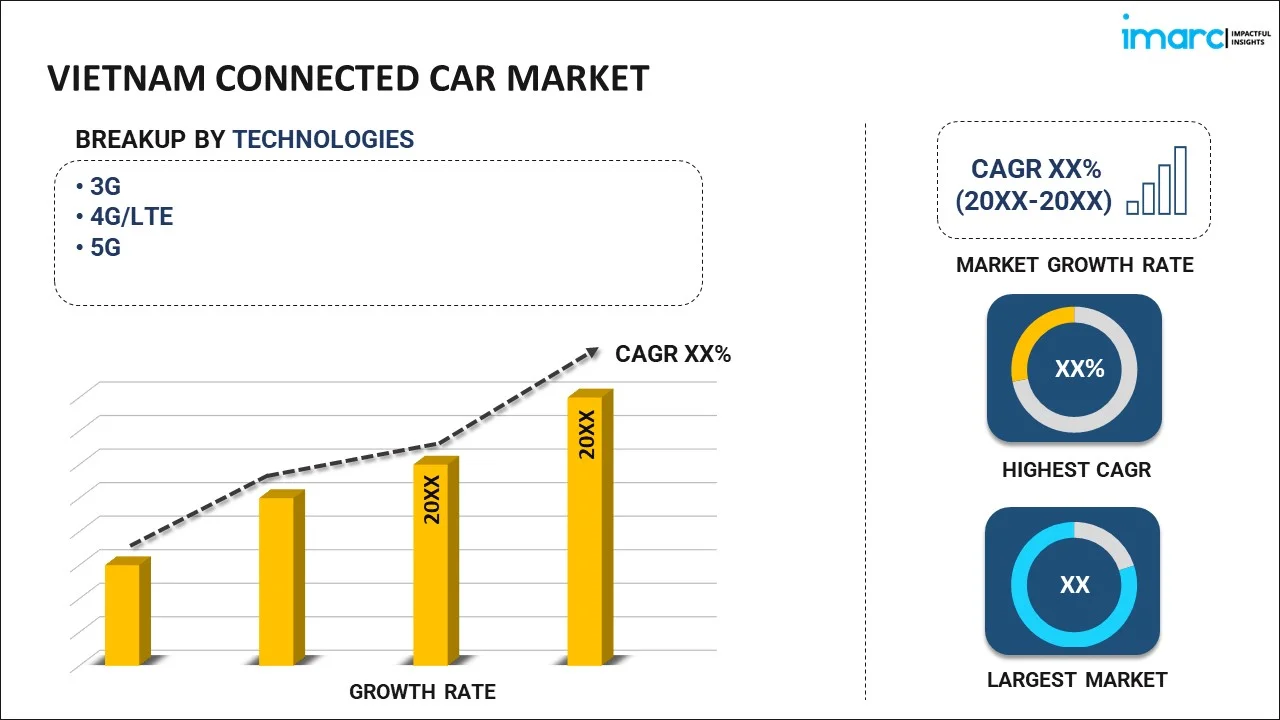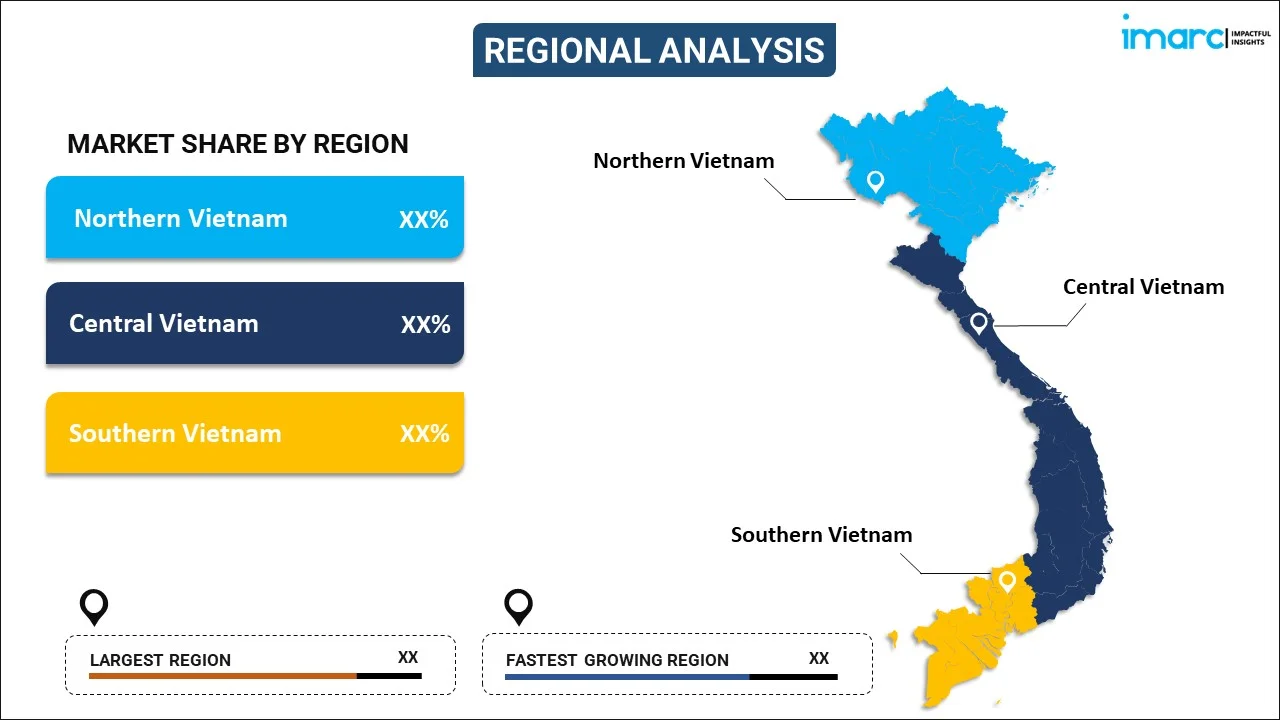
Vietnam Connected Car Market Report by Technology (3G, 4G/LTE, 5G), Connectivity Solution (Integrated, Embedded, Tethered), Service (Driver Assistance, Safety, Entertainment, Vehicle Management, Mobility Management, and Others), End Market (Original Equipment Manufacturer (OEMs), Aftermarket), and Region 2025-2033
Market Overview:
The Vietnam connected car market size is projected to exhibit a growth rate (CAGR) of 13.1% during 2025-2033. The rising consumer demand, rapid urbanization, supportive government initiatives, ongoing infrastructure development, heightened safety and security concerns, consumer creativity, growing trend of ride sharing and mobility services, and increasing environmental concerns represent some of the key factors driving the market.
|
Report Attribute
|
Key Statistics
|
|---|---|
|
Base Year
|
2024 |
|
Forecast Years
|
2025-2033
|
|
Historical Years
|
2019-2024
|
| Market Growth Rate (2025-2033) | 13.1% |
A connected car, also known as a "smart car," refers to an automobile equipped with advanced communication and connectivity features that enable it to interact with other devices, networks, and services. These vehicles are designed to enhance the overall driving experience, safety, and convenience for both drivers and passengers. Connected cars typically have integrated internet connectivity through cellular networks or other wireless technologies. This connectivity allows them to access real-time information, such as traffic updates, weather forecasts, and navigation assistance. Nowadays, connected cars often feature advanced driver assistance systems (ADAS) that can provide warnings and assistance in critical situations, improving road safety.
Vietnam Connected Car Market Trends:
As the economy of Vietnam continues to grow, there is a rising middle-class population with increased disposable incomes. This demographic shift has led to higher consumer demand for advanced automotive technologies, including connected car features, representing a major growth-inducing factor. Additionally, rapid urbanization in Vietnam is resulting in increased traffic congestion and a growing need for smart solutions to navigate through crowded city streets. Connected car technologies, such as real-time traffic updates and navigation assistance, are becoming essential for urban commuters. Along with this, due to a heightened focus on enhancing road safety, consumers are increasingly interested in features like automatic emergency braking, lane-keeping assistance, and vehicle-to-vehicle communication. These safety-related features are driving the adoption of connected cars. Besides this, the widespread use of smartphones in Vietnam means that consumers are already accustomed to connectivity and app-based services. This familiarity is making it easier for them to embrace connected car features that seamlessly integrate with their mobile devices. In line with this, the growing awareness about environmental issues is encouraging consumers to consider eco-friendly transportation options, including electric and hybrid vehicles that often come equipped with connected features, thus contributing to market growth. Furthermore, as more automakers and technology companies enter the Vietnamese market with a variety of connected car offerings, competition is intensifying. This competition is leading to constant innovation and driving down the costs of these technologies, making them more accessible to consumers. Apart from this, the Vietnamese government has shown interest in promoting the adoption of electric vehicles (EVs) and connected cars to address environmental concerns and reduce carbon emissions. This has led to favorable incentives and policies that encourage the development and adoption of connected car technologies, thereby fueling market growth. Connected car technologies allow for personalized in-car experiences. Consumers in Vietnam are attracted to the ability to customize their infotainment, comfort, and convenience settings, which enhances their overall driving experience. Moreover, automakers and service providers can monetize the data generated by connected cars. This potential revenue stream is incentivizing companies to invest in connected car technologies and services in Vietnam, further stimulating market growth.
Vietnam Connected Car Market Segmentation:
IMARC Group provides an analysis of the key trends in each segment of the market, along with forecasts at the country level for 2025-2033. Our report has categorized the market based on technology, connectivity solutions, service, and end market.
Technology Insights:

- 3G
- 4G/LTE
- 5G
The report has provided a detailed breakup and analysis of the market based on the technology. This includes 3G, 4G/LTE, and 5G.
Connectivity Solutions Insights:
- Integrated
- Embedded
- Tethered
A detailed breakup and analysis of the market based on the connectivity solutions have also been provided in the report. This includes integrated, embedded, and tethered.
Service Insights:
- Driver Assistance
- Safety
- Entertainment
- Vehicle Management
- Mobility Management
- Others
The report has provided a detailed breakup and analysis of the market based on the service. This includes driver assistance, safety, entertainment, vehicle management, mobility management, and others.
End Market Insights:
- Original Equipment Manufacturer (OEMs)
- Aftermarket
A detailed breakup and analysis of the market based on the end market have also been provided in the report. This includes original equipment manufacturer (OEMs) and aftermarket.
Regional Insights:

- Northern Vietnam
- Central Vietnam
- Southern Vietnam
The report has also provided a comprehensive analysis of all the major regional markets, which include Northern Vietnam, Central Vietnam, and Southern Vietnam.
Competitive Landscape:
The market research report has also provided a comprehensive analysis of the competitive landscape in the market. Competitive analysis such as market structure, key player positioning, top winning strategies, competitive dashboard, and company evaluation quadrant has been covered in the report. Also, detailed profiles of all major companies have been provided.
Vietnam Connected Car Market Report Coverage:
| Report Features | Details |
|---|---|
| Base Year of the Analysis | 2024 |
| Historical Period | 2019-2024 |
| Forecast Period | 2025-2033 |
| Units | Billion USD |
| Scope of the Report | Exploration of Historical and Forecast Trends, Industry Catalysts and Challenges, Segment-Wise Historical and Predictive Market Assessment:
|
| Technologies Covered | 3G, 4G/LTE, 5G |
| Connectivity Solutions Covered | Integrated, Embedded, Tethered |
| Services Covered | Driver Assistance, Safety, Entertainment, Vehicle Management, Mobility Management, Others |
| End Markets Covered | Original Equipment Manufacturer (OEMs), Aftermarket |
| Regions Covered | Northern Vietnam, Central Vietnam, Southern Vietnam |
| Customization Scope | 10% Free Customization |
| Post-Sale Analyst Support | 10-12 Weeks |
| Delivery Format | PDF and Excel through Email (We can also provide the editable version of the report in PPT/Word format on special request) |
Key Questions Answered in This Report:
- How has the Vietnam connected car market performed so far and how will it perform in the coming years?
- What has been the impact of COVID-19 on the Vietnam connected car market?
- What is the breakup of the Vietnam connected car market on the basis of technology?
- What is the breakup of the Vietnam Connected Car market on the basis of connectivity solutions?
- What is the breakup of the Vietnam connected car market on the basis of service?
- What is the breakup of the Vietnam connected car market on the basis of end market?
- What are the various stages in the value chain of the Vietnam connected car market?
- What are the key driving factors and challenges in the Vietnam connected car?
- What is the structure of the Vietnam connected car market and who are the key players?
- What is the degree of competition in the Vietnam connected car market?
Key Benefits for Stakeholders:
- IMARC’s industry report offers a comprehensive quantitative analysis of various market segments, historical and current market trends, market forecasts, and dynamics of the Vietnam connected car market from 2019-2033.
- The research report provides the latest information on the market drivers, challenges, and opportunities in the Vietnam connected car market.
- Porter's five forces analysis assist stakeholders in assessing the impact of new entrants, competitive rivalry, supplier power, buyer power, and the threat of substitution. It helps stakeholders to analyze the level of competition within the Vietnam connected car industry and its attractiveness.
- Competitive landscape allows stakeholders to understand their competitive environment and provides an insight into the current positions of key players in the market.
Need more help?
- Speak to our experienced analysts for insights on the current market scenarios.
- Include additional segments and countries to customize the report as per your requirement.
- Gain an unparalleled competitive advantage in your domain by understanding how to utilize the report and positively impacting your operations and revenue.
- For further assistance, please connect with our analysts.
 Inquire Before Buying
Inquire Before Buying
 Speak to an Analyst
Speak to an Analyst
 Request Brochure
Request Brochure
 Request Customization
Request Customization




.webp)




.webp)












